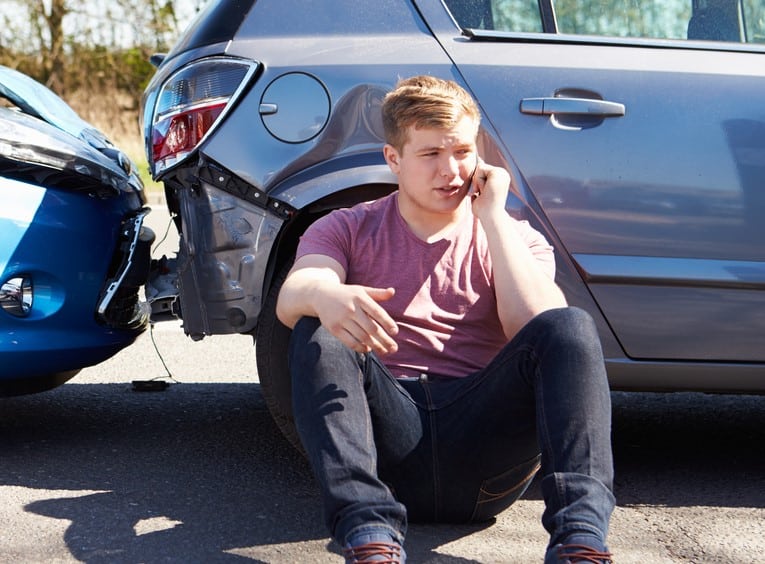Types of car insurance

Compulsory third party (CTP)
CTP insurance is the only mandatory type of car insurance in Australia. It covers injuries or death caused to others in an accident but not damage to property, other vehicles or the driver’s own injuries or vehicle.

Compulsory third party (CTP)
CTP insurance is the only mandatory type of car insurance in Australia. It covers injuries or death caused to others in an accident but not damage to property, other vehicles or the driver’s own injuries or vehicle.
What does car insurance cover?
| What’s covered | TPPD | TPFT | Comprehensive | CTP |
|---|---|---|---|---|
| Damage to another car due to an accident | ✓ | ✓ | ✓ | ✖ |
| Damage to your car by an uninsured driver | ✓ | ✓ | ✓ | ✖ |
| Any driver (additional excess may apply) | ✓ | ✓ | ✓ | ✖ |
| Damage to or loss of your car due to fire | ✖ | ✓ | ✓ | ✖ |
| Damage to or loss of your car due to theft | ✖ | ✓ | ✓ | ✖ |
| Hire car after theft | ✖ | ✓ | ✓ | ✖ |
| Towing after an insured incident | ✖ | ✓ | ✓ | ✖ |
| Emergency repairs | ✖ | ✓ | ✓ | ✖ |
| Damage to or loss of personal items | ✖ | ✓* | ✓ | ✖ |
| Damage to or loss of car seats | ✖ | ✓* | ✓ | ✖ |
| Damage to or loss of your car due to an accident | ✖ | ✖ | ✓ | ✖ |
| Damage to or loss of your car due to a weather-related incident | ✖ | ✖ | ✓ | ✖ |
| Hire car after an accident | ✖ | ✖ | ✓ | ✖ |
| New car replacement | ✖ | ✖ | ✓ | ✖ |
| Legal liability for injury or death to other people | ✖ | ✖ | ✖ | ✓ |
| * Benefit not available on all TPFT policies | ||||
What optional extras are available with car insurance?
Most insurers offer a range of optional extras that can be added to a policy for an additional cost. These extras can vary depending on the insurer, but some common ones include:
- Roadside assistance: roadside assistance provides immediate help to drivers during breakdowns or unexpected incidents while on the road. This can include emergency towing, fuel delivery, jump-starting, lockout assistance and flat tyre repair.
- Windscreen cover: this can cover the cost of repairing or replacing a damaged windscreen.
- Excess-free glass cover: additionally, you can often choose to have the cost of repairing or replacing any glass on your vehicle covered without you having to pay an excess.
- No-claim bonus protection: no-claim bonus protection can keep your no-claim bonus discount intact even if you make a claim. Without this protection, your premium may increase if you make a claim.
- Hire car cover: this can provide you with a temporary replacement vehicle if your car is damaged or stolen.
- Lifetime repair guarantee: with this extra, you can ensure any repairs made to your car are guaranteed for the life of the vehicle. This is often included as part of comprehensive car insurance automatically.
How much does car insurance cost?
Car insurance premiums in Australia have been growing steadily in recent years. According to the Insurance Council of Australia, premiums have increased by over 40% since 2019, averaging $1,052 a year in 2024. These increases are largely driven by rising costs for insurers, including higher claims, vehicle repair expenses and legal costs.
However, how much you’ll pay for your cover depends on a number of factors. As well as the type of insurance you choose, your premium will be influenced by:
- Age and driving experience: younger and less experienced drivers like P-platers usually face higher premiums due to the higher risk associated with inexperience.
- Type of vehicle: more expensive, powerful and newer vehicles tend to cost more to insure due to higher repair or replacement costs. Likewise, electric cars tend to have higher insurance costs.
- Driving history: a clean driving record typically results in lower premiums, while past accidents or traffic violations may raise your rates.
- Usage: if you use your vehicle for business purposes such as ridesharing or if you frequently drive long distances, you may have a higher premium.
- Location: your state and postcode also play a part. Living in an area with higher accident or theft rates may lead to higher premiums.
- Car parking: cars parked on the street often cost more to insure than those in a driveway or garage.
- Excess: in many cases, choosing a higher excess means lower car insurance premiums – but you’ll pay more out-of-pocket if you make a claim.
What is an excess in car insurance?
An excess is the amount you pay out-of-pocket when you make a claim on your car insurance. For example, if your excess is $200 and you claim for $2,000 worth of damage, your insurer would cover $1,800, and you would pay the remaining $200.
You’ll need to pay an excess each time you claim for an incident, in most cases before work can begin on your vehicle. Whether an excess will apply – and how much you’ll need to pay – depends on your policy and the type of claim.
Generally, choosing a higher excess can lower your premiums, while a lower excess may lead to higher premiums.
Example car insurance premiums
| Driver profile | Vehicle | Premiums from |
|---|---|---|
| 40-year-old male, Sydney | 2018 Volkswagen Golf | $466 |
| 40-year-old male, Sydney | 2025 Toyota LandCruiser Prado Kakadu | $1,649 |
| 21-year-old male, Sydney | 2018 Volkswagen Golf | $512 |
| 21-year-old male, Sydney | 2025 Toyota LandCruiser Prado Kakadu | $1,990 |
| Source: Compare the Market Profiles are based on a male driver in Sydney with a full driver’s licence and no prior claims, driving 15,000km a year. Quotes are based on an excess of $600–$700. |
||
As you can see, the cost of car insurance can vary quite a bit depending on both the car and the driver. Newer, higher-value vehicles like the LandCruiser Prado generally cost more to insure than used models such as the Volkswagen Golf. Younger drivers also tend to pay higher premiums, as they’re considered higher risk by insurers.
Why does insurance for an electric car cost more?
While insurance policies for electric vehicles provide the same cover as for petrol or diesel cars, insuring these cars is often more expensive because EVs typically have higher purchase prices and repair costs. Their batteries are expensive to replace, and advanced technology and electronics can make repairs more complex. In addition, there are fewer specialist mechanics, which can lead to higher labour costs. As an example, were the same 40-year-old from the example above to insure a 2025 Kia EV5, they could be looking at premiums over $1,700 a year plus a higher excess for comprehensive cover, according to quotes available through Compare the Market in October 2025. Other EVs, such as Tesla models, can cost even more to insure.
Tips for getting the cheapest car insurance policy
-
Look for discounts
Many insurers offer discounts for new sign-ups, safe driving or bundling your car insurance with other policies. Additionally, you may be able to find special promotions or loyalty rewards, such as discounts for remaining claim-free for a certain period.
-
Consider additional benefits
Some insurers offer additional perks, like frequent flyer points or discounts on everyday purchases like supermarket shopping, which can provide extra value beyond just a low premium.
-
Raise your excess
Opting for a higher excess often results in a lower premium. If you're comfortable paying a higher excess in the event of a claim, this can help reduce your annual costs.
-
Pay annually, not monthly
While it’s a bigger upfront cost, paying in one lump sum rather than monthly can mean lower premiums as many insurers charge extra fees for monthly payments.
-
Avoid unnecessary extras
While extras like roadside assistance or hire car coverage may be useful, they can add to your premium. If you don't think you'll need them, consider skipping these add-ons to keep costs down.
-
Choose market value insurance
Insuring your car for its market value – where the insurer will determine how much the car is worth at the time of the claim – instead of an agreed value determined at the start of the policy can lower premiums.
-
Think about how much you drive
If you don’t drive often, consider a low-mileage policy (under 15,000 km per year) or a pay-as-you-go policy. Paying based on the kilometres you actually drive can significantly reduce your premium.
How to buy a car insurance policy through Savvy
-
Start your application
We’ll connect you with our partner, Compare the Market, to start comparing.
-
Enter your details
Provide information about your car, yourself and your driving history.
-
Access your quotes
Compare a range of quotes from partnered insurance providers.
-
Purchase your policy
Choose your policy and get covered in minutes.
Why compare car insurance policies through Savvy?
100% free comparisons
There's no need for you to pay a cent to compare a variety of competitive policies side-by-side.
Any time, anywhere
Because all our tools are available online, you can compare car insurance policies no matter where you live, day or night.
Reputable partners
We're partnered with Compare the Market to help our customers lock in the best deal tailored to their needs.
Car insurance top tip

Save money by downgrading your cover
"If your car is only worth a few thousand dollars and you're close to upgrading, it might be a smarter financial decision to downgrade to third party cover (if you haven't already). That way if you're at fault in an accident, you're still covered for damage caused to another vehicle.
It's a bit of a gamble, but you could potentially save up to $1,000 if you were to do this and not have an accident. That money could go towards buying your next car."

Market value vs agreed value car insurance
One option you may have when taking out car insurance is to insure your vehicle for its market value or agreed value.
Market value means you’ll receive the estimated value of your car in the current market if it’s written off or stolen. Agreed value, on the other hand, is a value agreed upon before the policy begins in the event your car is stolen or written off.
Case study #1 – market value insurance policy
Lauren wants a new insurance policy for her ten-year-old sedan. She decides to take out a market value car insurance policy, as it has a lower premium than the agreed value option and she doesn’t think being covered for a few thousand dollars more on an older car is worth the extra cost.
Nine months later, Lauren is involved in an accident that writes off her car. She makes a claim to her insurance company, which determines her car’s market value to be $7,500. This suits Lauren, as she knew she wouldn’t realistically receive a big payout for her car. The payout will be enough to cover most of her next car purchase, with the rest funded by her savings.
Case study #2 – agreed value insurance policy
James is looking to insure his brand-new sports car, which he just bought for $70,000. He wants to ensure he has adequate coverage in case it’s stolen or written off, so he chooses an agreed value policy. This means James can ask his chosen insurer to agree to insure the car for the amount he just paid for it, though his premiums will be higher.
Three months later, James’ car is stolen. He submits a claim with his insurer and is paid the agreed $70,000 sum. In this instance, James receives more than he would have under a market value policy, as his car’s value would have dropped over the three months he’d owned it.
- Insurance industry releases motor insurance roadmap - Insurance Council of Australia






